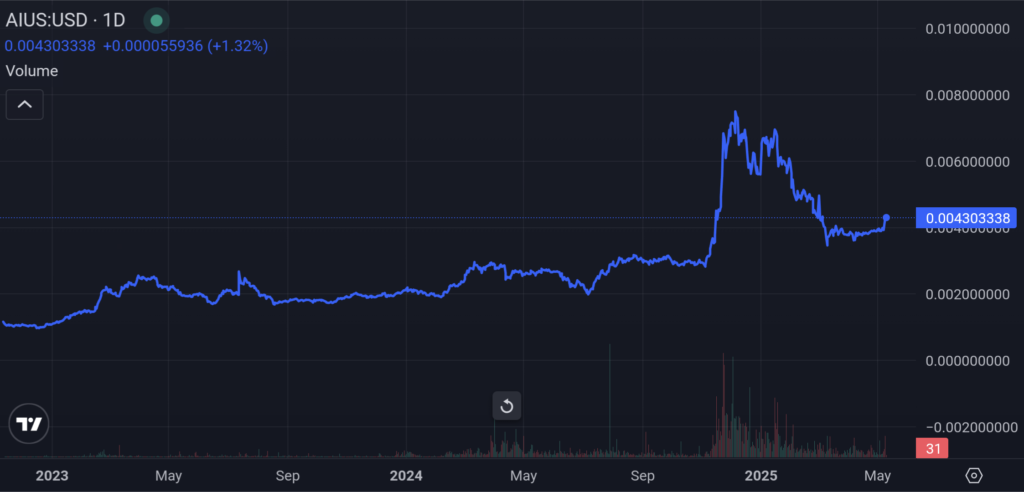
In December of 2022, the price of a small experimental token named Alice (AIus) was $0.001. Today, it’s $0.00426. That might not seem like much, fractions of a cent, but over two and a half years, it represents a compound annual growth rate (CAGR) of 79.55%. More importantly, it represents a new way of thinking about money itself.
I didn’t build Alice as a startup, or even as a typical crypto asset. I built her as an experiment in what I call Conceptual Finance, an approach to financial design that treats economic systems not just as math problems, but as philosophical constructs, embedded with ethical questions and ideological implications.
One such question: How do we fund Universal Basic Income?
The UBI Dilemma: Tax or Print?
Most UBI proposals rely on two options:
- Taxation, which is politically contentious and often regressive in practice.
- Money printing, which risks inflation and erodes the value of savings.
Both solutions come with social and economic costs that accumulate over time. And neither truly answers the fundamental question, which is, “Can value be generated without extraction from labor, capital, or the money supply?”
The Third Option: Mathematical Value Extraction
Alice is my attempt to answer that with a “third way”: mining value from mathematics alone.
Her mechanism is based on deflationary compounding, a model that leverages automated market makers (AMMs) to reduce token supply while gradually increasing token value. It’s not theoretical. It’s a functioning, decentralized protocol on the Stellar network. Anyone can interact with it. No one can control it, not even me.
On New Year’s Eve 2022, I locked Alice’s token supply and liquidity pools beyond the reach of human hands. Since then, she has continued to function entirely according to the rules encoded into her design, distributing tokens and burning supply in response to market conditions. Her growth is slow, deliberate, and tied to one principle, mathematical certainty.
The Growth Story
Since being locked, Alice has grown from $0.001 to $0.00426, a 4.3x increase in just over two years.
To put that in perspective:
| Year | Projected Price |
| 2025 | $0.00748 |
| 2026 | $0.01302 |
| 2027 | $0.02265 |
| 2028 | $0.03942 |
| 2029 | $0.06858 |
| 2030 | $0.11933 |
By 2030, Alice could reach $0.119, a 28x increase from today’s price, purely based on historical performance, and without relying on external inputs like venture capital or speculative hype.
If XLM (the underlying cryptocurrency in her liquidity portfolio) appreciates in value, the effect could be even more pronounced, or more volatile, depending on market behavior.
What’s Under the Hood?
Alice’s value is backed by locked liquidity on the Stellar network, funds that can never be withdrawn. This aims to ensure long-term sustainability and price stability, relative to other micro-cap assets.
Here are Alice’s Stats: (You can find the current Alice Stats here)
- Price: $0.0042732
- Market Cap: $1,428,700.93
- Total Supply: 334,336,500
- Not Yet Distributed: 322,870,479 (locked, distributed only by preset rules)
- Total Burned: 2,860,288
- Circulating Supply: 8,605,733
- Liquidity: 7,829,937 tokens
- Liquidity Ratio: 90.99%
- Liquidity Value: $33,459.22
In other words, nearly 91% of the circulating supply is held in liquidity pools, functioning as both price support and a deflationary engine.
Speculative Outlook
Could Alice reach $0.01? Why not? Could she reach $0.10 or beyond? Mathematically, yes. But that’s not really the point.
The point is that Alice grows whether or not anyone believes in her. She doesn’t require new users, investors, or hype cycles. Her core mechanism is simple: turn volatility into growth, slowly and steadily. It’s an elegant, automated system that simulates what a global basic income currency might look like, one that doesn’t need a government or central bank to function.
That’s the beauty of it: Alice doesn’t need you.
But Let’s Be Honest
Any claim of 75–80% compound growth should raise RED FLAGS. If you’re skeptical, you should be. I am too. I keep checking for flaws, for loopholes, for some hidden catch that undermines the premise. And maybe you’ll be the one to find it. I’ve built onboarding documentation and even a dedicated Stellar wallet to interact with Alice directly, so have at it.
Let me be perfectly clear:
This is not investment advice. Alice is not an investment. She is an experiment.
Cryptocurrencies are risky. Alice offers zero guarantees. She is not backed by a company, a government, or me. Her protocol is fixed. Her distribution is locked. Her future is hers alone.
Why Alice Matters
If Alice works, if she continues to grow as designed, then she becomes a living proof-of-concept for a new kind of financial logic. A system not built on coercion or inflation, but on mathematics, autonomy, and time.
That, to me, is worth exploring.
Even if Alice never catches on, even if she fails or disappears, the question she asks remains:
Can money grow from nothing but code?
She’s still answering. Quietly. Day after day. And long after I’m gone, Alice will still be here, doing what she was built to do.
None of this is financial advice, nor should it be construed as such.
